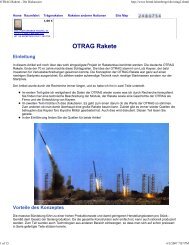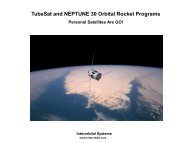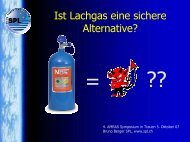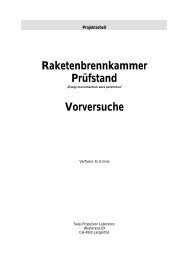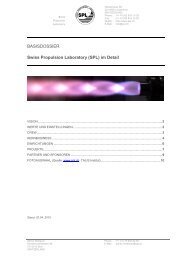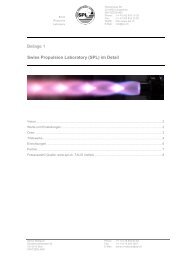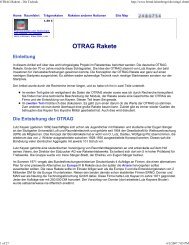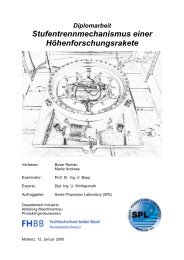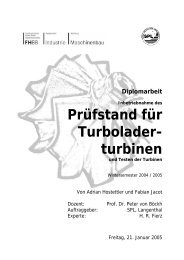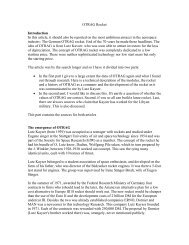Is nitrous oxide safe? - Swiss Propulsion Laboratory
Is nitrous oxide safe? - Swiss Propulsion Laboratory
Is nitrous oxide safe? - Swiss Propulsion Laboratory
- No tags were found...
You also want an ePaper? Increase the reach of your titles
YUMPU automatically turns print PDFs into web optimized ePapers that Google loves.
Potential ti risks• N 2 O is normally used under saturated condition: 2-phase flow with high potential ofwater hammering adiabatic compression of cavitation bubbles "Dieseling"specially when contaminated with fuel and at combustible surfaces like seals, fillinghoses, carbon fiber tanks etc.)Imploding vapor bubble with jet (up to100000 bar at the ground of the jet andtemperatures of several thousand K !)7 © SPL, 5.10.2007
Potential ti risks 2N 2 O is a monopropellant (as H 2 O 2 or Hydrazine)!• Under certain conditions more energy is produced by the decomposition thannecessary to reach the decomposition temperature run away reaction!N 2 O(g) —> N 2 (g) + ½O 2 (g) + 82 kJ/mol• Particularly the vapor phase can lead to a deflagration or even a detonation atpressures > 5.7 bar if a contamination of fuel is present• Catalysts can lower the critical temperature to 250 °C (E.g. copper and its <strong>oxide</strong>s)8 © SPL, 5.10.2007
Potential ti risks 2• Very good solubility in oil, grease and other hydrocarbons like plastics etc. (That's whyit works so well for whipped cream). Also solid plastics like HTPB or fiber reinforcedplastics can be saturated when exposed to <strong>nitrous</strong> <strong>oxide</strong> for a long period and canthen transform to a high explosive.• According to several sources, electro static discharge during injection into acombustion chamber can occur. Combined with the point above this can lead to anunexpected disassembling of the engine.• Freezing of valves and venting orifices.• Unknown Voodoo [5]:9 © SPL, 5.10.2007
Suggestions• Δp over injector > 10 bar. A screaming hybrid is a sign for combustion instabilities andtherefore for a too low Δp.• Only use the liquid phase• For hybrids: Do not expose the grain to <strong>nitrous</strong> <strong>oxide</strong> for a long period (no saturationof the grain). Venting and dumping not through the combustion chamber• Electr. ground tanks etc.• NO combustibles materials for seals, hoses (also filling hose) and tanks (e.g. Fiberreinforced ones without metallic liner). Metals (INOX, Alu), PTFE, PCTFE or someSilicones are ok. Viton, FKM, FPM are chemical compatible but are swellingsignificantly when exposed to N 2 O. Avoid copper alloys. Only use compatible lubricantslike CRYTOX. Ask your supplier for chemical and physical compatibility with N 2 O!• Stay below the critical diameter in the feeding lines by using some kind of deflagrationtrap (E.g. a big sintered metallic filter, bundle of tubes etc) [8]• Use burst disks at the tank.• Hydro testing the tanks > 100-150 bar.• Density of N 2 O change significantly with temperature. Do not fill the tank completely:13-15% 15% ullage for a possible temperature increase from 15°C to25°C [6],[7]10 © SPL, 5.10.2007
Suggestions• Remote operated filling and draining. Electrical ground the tanks and filling lines• Attention after unsuccessful ignition. With N 2 O saturated grain or other fuel can beexplosive.• To avoid bubbles and therefore cavitation: Use sub cooled N 2 O and pressurize it withN 2 or Helium.• Use LOX ;-)• Let me know if you have other suggestions or you think I am paranoid:bruno.berger@spl.ch11 © SPL, 5.10.2007
ConclusionRocket propellants are high energetic materials (That’s whywe use it) and therefore potential dangerous! As everyoxidizer, <strong>nitrous</strong> <strong>oxide</strong> has it’s vantages but also it’s pitfalls.Even N 2 O can be handled d and operated in a <strong>safe</strong> wayprovided you are aware of the risks. This is also true for otheroxidizers like LOX, H 2 O 2, N 2 O 4 and nitric acid etc.12 © SPL, 5.10.2007
Sources1. "Nitrous Oxide Trailer Rupture, July 2, 2001" Presentation of Mr. Konrad Munke,Linde Gas AG2. "Untersuchungen von Zerfallsfähigkeit von Disticksoffoxid", research report 89,Bundesanstalt für Materialprüfung BAM, 19833. Pictures and movie from Troy Prideaux4. Movie Henrik Schulz DARK, http://www.dark.dk/5. "Investigations of Decomposition Characteristics of gaseous and liquid NitrousOid"b Oxide" by G.W. GWRhd Rhodes, AD-784 AD784 802, Air Force Weapons <strong>Laboratory</strong>, KirtlandAirforce Base, 19746. "Calculation and Verification of Filling Ratios for Liquified Gases DTRS56-02-X-0049" NIST and DOT7. http://www.aspirespace.org.uk/ (technical papers)8. Flame Propagation in Gaseous Nitrous Oxide by A. A. Borisova, K. Ya. Troshina, andYu. S.BiryulinbOthers:• Catalytic Ignition of Nitrous Oxide With Propane/Propylene Mixtures for RocketMotors, AIAA 2005-3919• Catalytic Decomposition of Nitrous Oxide for Spacecraft <strong>Propulsion</strong>, ADA 39293513 © SPL, 5.10.2007
Questions ????Contact and further info‘s:WWW.SPL.CH14 © SPL, 5.10.2007



